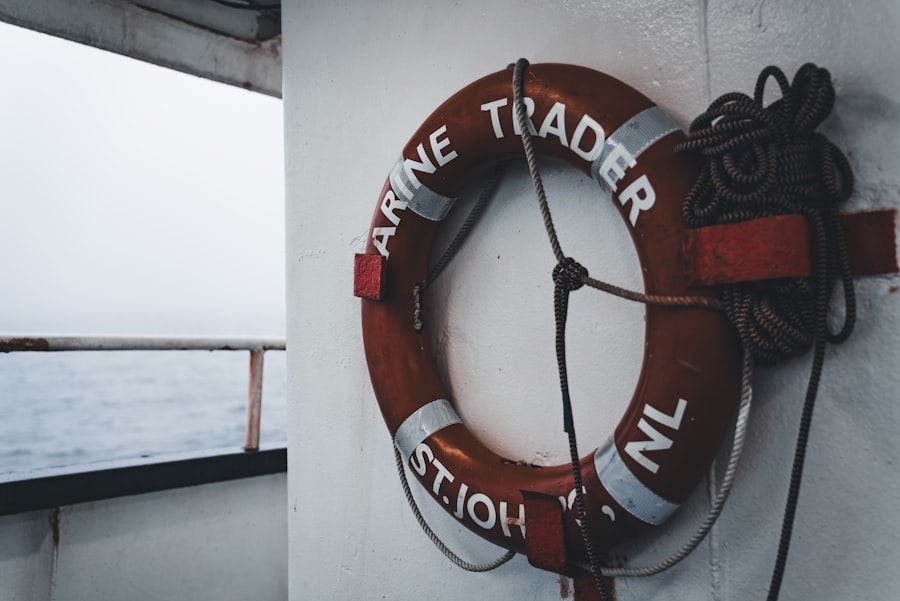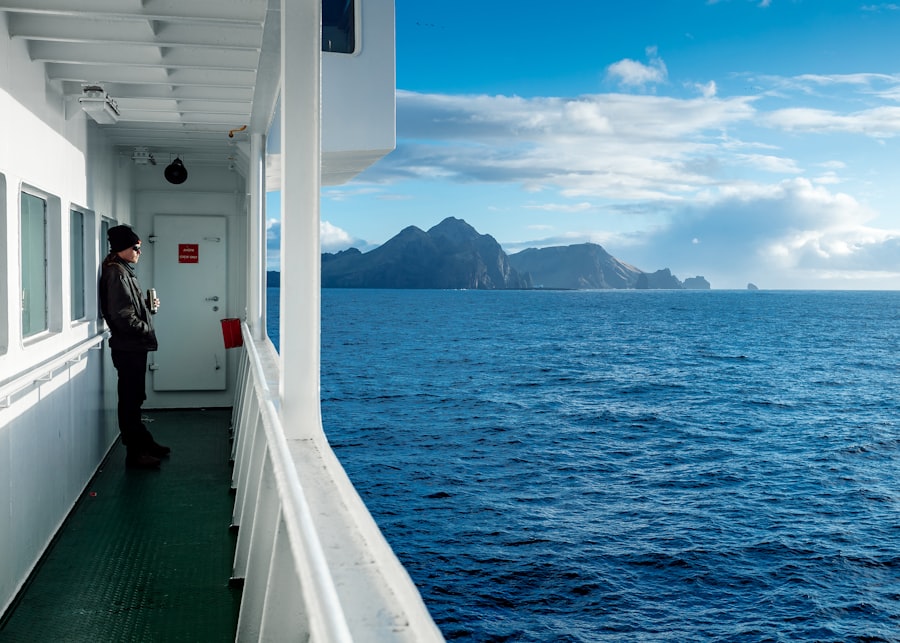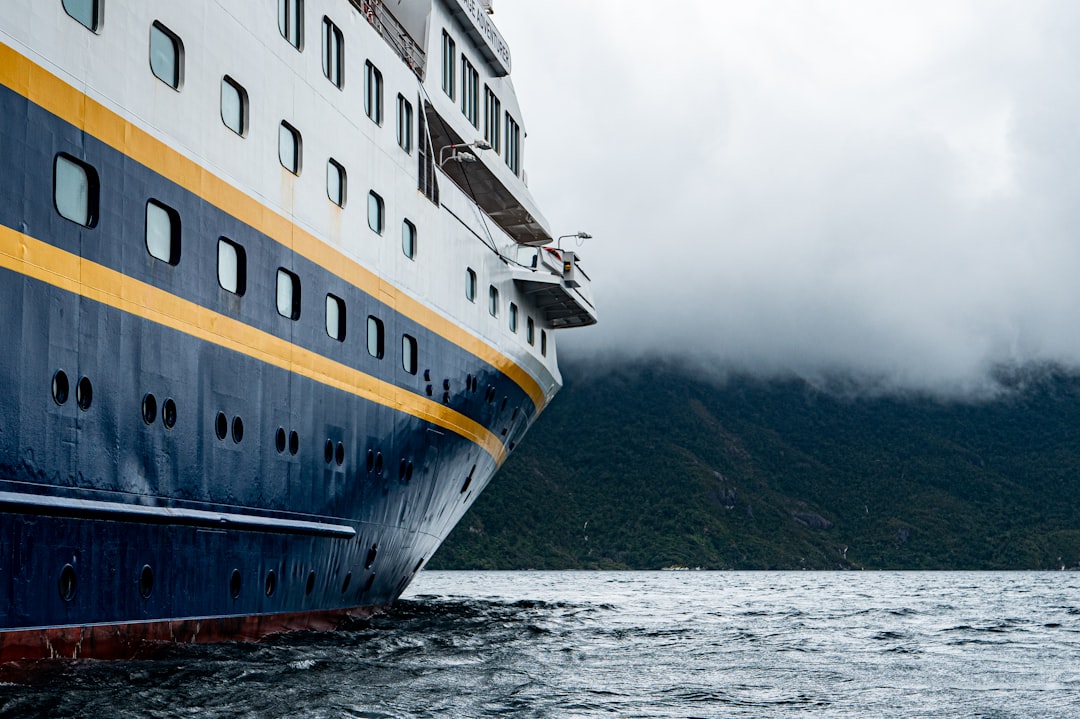The Drake Passage, a body of water situated between the southern tip of South America and Antarctica, is renowned for its tumultuous seas and unpredictable weather. Spanning approximately 600 miles, this passage serves as a critical maritime route for vessels venturing to the Antarctic region. Named after the English explorer Sir Francis Drake, who navigated these waters in the late 16th century, the Drake Passage has become synonymous with adventure and peril.
It is often described as one of the most challenging maritime routes in the world, attracting both seasoned sailors and adventurous cruise passengers eager to experience its unique allure. The significance of the Drake Passage extends beyond its geographical location; it is a vital conduit for marine life and plays a crucial role in global oceanic currents. The confluence of the Atlantic and Pacific Oceans creates a dynamic environment that supports a diverse array of wildlife, making it an essential area for ecological research and exploration.
As cruise tourism to Antarctica continues to grow, understanding the complexities of navigating the Drake Passage becomes increasingly important for ensuring passenger safety and environmental preservation.
Key Takeaways
- The Drake Passage is a body of water between South America’s Cape Horn and the South Shetland Islands of Antarctica, known for its challenging sailing conditions.
- Weather conditions in the Drake Passage can be extreme, with strong winds, high waves, and rapidly changing weather patterns, making it one of the roughest seas in the world.
- Safety measures for cruise ships in the Drake Passage include reinforced hulls, stabilizers, and advanced navigation systems to ensure the safety and comfort of passengers and crew.
- Historical incidents in the Drake Passage, such as the sinking of the MS Explorer in 2007, highlight the risks associated with navigating this treacherous waterway.
- Advancements in technology for safe passage, including satellite communication, ice radar, and weather forecasting, have significantly improved the safety of cruise ships in the Drake Passage.
- Wildlife and environmental considerations in the Drake Passage include strict regulations to protect the delicate ecosystem and wildlife, such as penguins, seals, and whales.
- The importance of experienced crew and staff is crucial for navigating the Drake Passage, as their expertise and knowledge are essential for ensuring a safe and enjoyable cruise experience.
- Alternative routes and options for cruising, such as the Beagle Channel or the Antarctic Peninsula, provide safer alternatives for passengers who may be concerned about the challenging conditions of the Drake Passage.
- Passenger experiences and testimonials often highlight the thrill and sense of adventure that comes with crossing the Drake Passage, as well as the comfort and security provided by modern cruise ships.
- Regulations and guidelines for cruise ships in the Drake Passage are enforced by international maritime organizations to ensure the highest safety standards are met for all vessels navigating this challenging route.
- In conclusion, while the Drake Passage presents unique challenges, with modern technology, experienced crews, and adherence to strict regulations, cruise ships can safely navigate this legendary waterway.
Weather conditions in the Drake Passage
The weather conditions in the Drake Passage are notoriously volatile, characterized by strong winds, high waves, and rapidly changing temperatures. The convergence of cold Antarctic waters with warmer currents from the north creates a unique climatic environment that can shift dramatically within a matter of hours. This unpredictability poses significant challenges for vessels traversing the passage, as sudden storms can arise without warning, leading to treacherous sailing conditions.
Mariners often refer to the Drake Passage as “the most turbulent stretch of water in the world,” a title that underscores the need for caution and preparedness. Cruise ships navigating these waters must be equipped to handle extreme weather scenarios. The passage is known for its infamous “Drake Shake,” where waves can reach heights of over 30 feet during storms.
Such conditions can lead to discomfort for passengers and pose risks to the vessel’s stability. Therefore, understanding the seasonal variations in weather patterns is crucial for cruise operators. Typically, the summer months from November to March offer relatively milder conditions, making this period the most favorable for Antarctic expeditions.
However, even during these months, travelers must remain vigilant and prepared for sudden changes in weather.
Safety measures for cruise ships in the Drake Passage

Given the challenging conditions of the Drake Passage, cruise operators have implemented a range of safety measures to protect both passengers and crew. Modern cruise ships are designed with advanced stabilization technology that helps mitigate the effects of rough seas. These systems work by adjusting the ship’s position in response to wave movements, providing a smoother ride and reducing the risk of seasickness among passengers.
Additionally, many vessels are equipped with ice-strengthened hulls, allowing them to navigate icy waters safely. Crew training is another critical aspect of safety in the Drake Passage. Crew members undergo rigorous training programs that include emergency response drills and navigation techniques specific to this region.
This preparation ensures that they are well-equipped to handle any unforeseen circumstances that may arise during a voyage. Furthermore, cruise lines often employ experienced captains who have extensive knowledge of the passage’s unique challenges, enhancing overall safety during transit.
Historical incidents in the Drake Passage
| Year | Incident | Description |
|---|---|---|
| 1970 | Shipwreck | Argentine ship wrecked on the coast of King George Island |
| 1985 | Oil spill | Chilean vessel spilled 600,000 liters of oil in the area |
| 2007 | Rescue operation | Chilean Navy rescued 120 people from a sinking ship |
The Drake Passage has a storied history marked by numerous incidents that highlight its perilous nature. One notable event occurred in 1914 when Ernest Shackleton’s ill-fated expedition aboard the Endurance sought to cross the passage en route to Antarctica. The ship became trapped in pack ice, leading to a harrowing survival story that has since become legendary.
Shackleton’s crew endured extreme conditions for months before ultimately being rescued, illustrating both the dangers of navigating these waters and the resilience of those who venture into them. Another significant incident took place in 1989 when the cruise ship M.S. Explorer sank after striking an iceberg in the Drake Passage.
This tragedy served as a wake-up call for the cruise industry regarding safety protocols and emergency preparedness in polar regions. Following this incident, regulations were tightened, leading to improved safety measures and better training for crew members operating in these challenging waters. Such historical events underscore the importance of vigilance and preparedness when traversing the Drake Passage.
Advancements in technology for safe passage
In recent years, advancements in maritime technology have significantly enhanced safety measures for vessels navigating the Drake Passage. Modern ships are now equipped with sophisticated navigation systems that utilize satellite technology to provide real-time data on weather conditions and sea states. These systems allow captains to make informed decisions about routing and timing, helping to avoid dangerous weather patterns whenever possible.
Additionally, innovations in hull design and materials have improved vessel performance in rough seas. Many contemporary cruise ships feature hydrodynamic designs that reduce drag and enhance stability, allowing them to navigate turbulent waters more effectively. Furthermore, onboard monitoring systems can detect potential issues before they escalate, enabling proactive maintenance and ensuring that vessels remain seaworthy throughout their journeys.
Wildlife and environmental considerations in the Drake Passage

The Drake Passage is not only a challenging maritime route but also a vital ecosystem teeming with diverse marine life. The nutrient-rich waters support an array of species, including whales, seals, penguins, and various seabirds. As cruise tourism increases in this region, it becomes imperative to balance human activity with environmental conservation efforts.
Cruise operators are increasingly adopting sustainable practices to minimize their impact on local wildlife and habitats. One such initiative involves implementing strict guidelines regarding waste management and emissions control on board vessels. Many cruise lines have adopted advanced waste treatment systems that ensure all waste is processed responsibly before being discharged into the ocean.
By fostering a culture of respect for nature, cruise operators can help protect the delicate ecosystems that thrive within the Drake Passage.
Importance of experienced crew and staff
The significance of having an experienced crew cannot be overstated when navigating the unpredictable waters of the Drake Passage. Crew members play a crucial role in ensuring passenger safety and comfort throughout the journey. Their expertise allows them to respond effectively to changing conditions and manage any emergencies that may arise during transit.
Experienced staff members are also adept at providing valuable insights into the region’s history, wildlife, and geography, enriching passengers’ overall experience. Moreover, seasoned crew members often possess intimate knowledge of local maritime routes and weather patterns acquired through years of experience. This familiarity enables them to make informed decisions about navigation and timing, ultimately enhancing safety during voyages through this challenging passage.
The combination of technical skills and local knowledge ensures that passengers can embark on their Antarctic adventures with confidence.
Alternative routes and options for cruising
While the Drake Passage is a popular route for Antarctic cruises, there are alternative options available for those seeking different experiences or wishing to avoid its notorious conditions. One such alternative is the Beagle Channel, which offers a more sheltered passage through southern Chilean waters. Although this route may take longer than crossing the Drake Passage directly, it provides a calmer sailing experience while still allowing access to stunning landscapes and wildlife.
Another option is to embark on cruises that focus on specific regions within Antarctica rather than attempting a full crossing of the Drake Passage. These itineraries often include visits to remote islands or coastal areas where passengers can engage in activities such as kayaking or wildlife watching without venturing into more turbulent waters. By offering diverse cruising options, operators can cater to varying preferences while ensuring passenger comfort and safety.
Passenger experiences and testimonials
Passengers who have ventured through the Drake Passage often share mixed experiences that reflect both the challenges and rewards of this journey. Many travelers describe their crossing as exhilarating yet daunting, with some recalling moments of intense rocking as waves crashed against the ship’s hull. However, these challenges are frequently overshadowed by awe-inspiring views of icebergs and marine life encountered along the way.
Testimonials from passengers highlight not only the thrill of navigating such a renowned passage but also the camaraderie formed among fellow travelers during rough seas. Shared experiences often lead to lasting friendships as individuals bond over their mutual love for adventure and exploration. Ultimately, many passengers express that despite any discomfort experienced during their crossing, the opportunity to witness Antarctica’s breathtaking beauty makes it all worthwhile.
Regulations and guidelines for cruise ships in the Drake Passage
To ensure safe navigation through the Drake Passage, various regulations and guidelines have been established by international maritime organizations and national authorities. These regulations encompass aspects such as vessel design standards, crew training requirements, and environmental protection measures aimed at safeguarding marine ecosystems. Cruise operators must adhere to strict guidelines regarding passenger capacity limits and safety equipment onboard vessels operating in polar regions.
Additionally, many countries require ships to carry contingency plans outlining emergency procedures specific to navigating challenging waters like those found in the Drake Passage. Compliance with these regulations not only enhances passenger safety but also promotes responsible tourism practices within this fragile environment.
Is the Drake Passage safe for cruise ships?
In conclusion, while navigating the Drake Passage presents inherent challenges due to its unpredictable weather conditions and turbulent seas, advancements in technology and rigorous safety measures have significantly improved overall safety for cruise ships operating in this region. The importance of experienced crew members cannot be understated; their expertise plays a vital role in ensuring passenger safety while enhancing their overall experience. As awareness grows regarding environmental considerations and sustainable practices within this unique ecosystem, cruise operators are increasingly committed to minimizing their impact on local wildlife while providing unforgettable journeys for travelers seeking adventure in one of Earth’s most remote destinations.
Ultimately, with proper preparation and adherence to regulations, cruising through the Drake Passage can be both safe and rewarding for those willing to embrace its challenges.
The Drake Passage is notorious for its challenging conditions, often raising concerns about the safety of cruise ships navigating these treacherous waters.
This article delves into the factors that contribute to the passage’s reputation and offers guidance for travelers considering this adventurous route. You can read more about it by visiting the following link: MyGeoQuest’s article on the Drake Passage.
WATCH NOW! Drake Passage: Earth’s Deadliest Waters Revealed
FAQs
What is the Drake Passage?
The Drake Passage is the body of water between the southern tip of South America and the northern tip of the Antarctic Peninsula. It is known for its rough seas and challenging sailing conditions.
Is the Drake Passage dangerous for cruise ships?
The Drake Passage is known for its unpredictable and often rough seas, making it a challenging area for cruise ships to navigate. However, with modern technology and experienced crew, cruise ships can safely traverse the Drake Passage.
What are the potential dangers of the Drake Passage for cruise ships?
The main dangers of the Drake Passage for cruise ships include rough seas, strong winds, and icebergs. These conditions can lead to rough sailing and potential discomfort for passengers.
How do cruise ships prepare for sailing through the Drake Passage?
Cruise ships that plan to sail through the Drake Passage typically have experienced crew and captains who are familiar with the area. They also use advanced weather forecasting and navigation technology to plan their route and avoid the worst of the conditions.
Are there any safety measures in place for cruise ships in the Drake Passage?
Cruise ships sailing through the Drake Passage are required to adhere to international maritime safety regulations, including having appropriate life-saving equipment, emergency procedures, and trained crew members to ensure the safety of passengers and crew.
